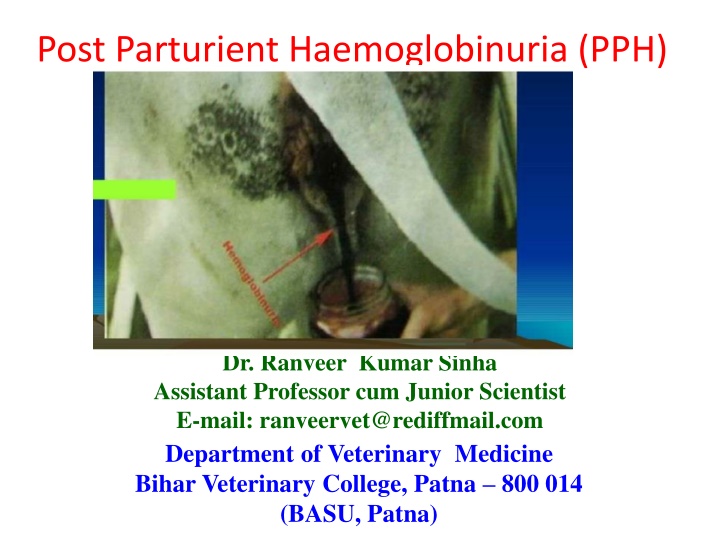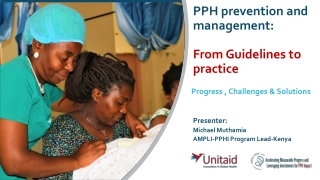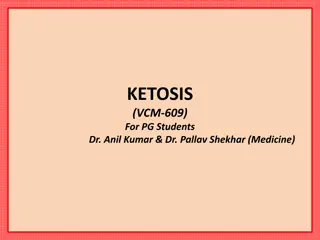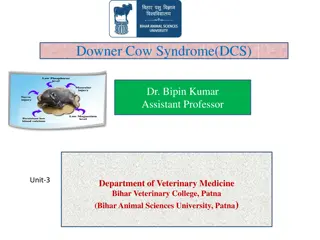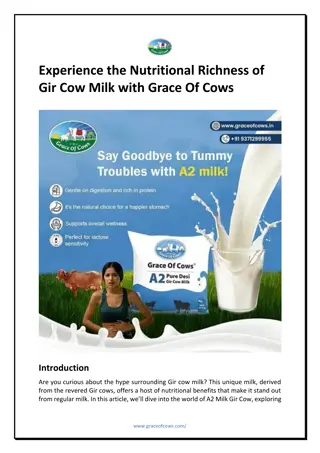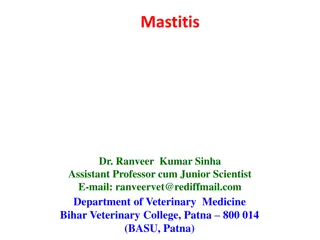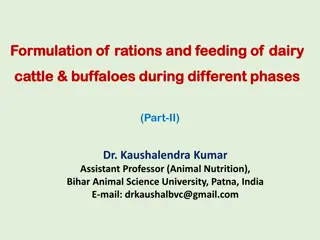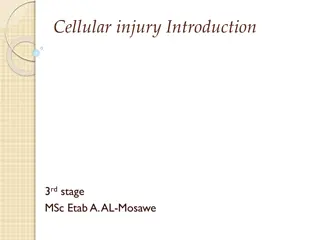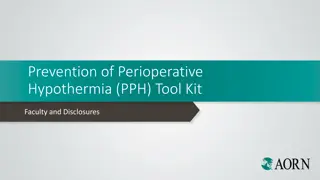Post-Parturient Haemoglobinuria (PPH) in Dairy Cows and Buffaloes: Causes and Clinical Manifestations
Post-Parturient Haemoglobinuria (PPH) is a metabolic disease affecting high-producing dairy cows and buffaloes. It is characterized by intravascular hemolysis, hemoglobinuria, and anemia. The condition is mainly caused by phosphorus deficiency, ingestion of certain plants, and increased phosphorus requirements during pregnancy. Clinical signs include dark red-brown to black urine and changes in milk color. Understanding the etiology, epidemiology, and pathogenesis of PPH is crucial for effective management and prevention strategies.
Download Presentation

Please find below an Image/Link to download the presentation.
The content on the website is provided AS IS for your information and personal use only. It may not be sold, licensed, or shared on other websites without obtaining consent from the author.If you encounter any issues during the download, it is possible that the publisher has removed the file from their server.
You are allowed to download the files provided on this website for personal or commercial use, subject to the condition that they are used lawfully. All files are the property of their respective owners.
The content on the website is provided AS IS for your information and personal use only. It may not be sold, licensed, or shared on other websites without obtaining consent from the author.
E N D
Presentation Transcript
Post Parturient Haemoglobinuria (PPH) Dr. Ranveer Kumar Sinha Assistant Professor cum Junior Scientist E-mail: ranveervet@rediffmail.com Department of Veterinary Medicine Bihar Veterinary College, Patna 800 014 (BASU, Patna)
Introduction Synonym:- Hypophosphataemia, Metabolic or Nutritional Haemoglobinuria Definition:- It is a metabolic disease of high producing dairy cows and buffaloes, characterized by intravascular haemolysis, haemoglobinuria and anaemia.
Etiology Def. of P in diet:- Soil def. in P Hay, straws & plant rich in oxalate are naturally deficient in P Drought, reduces P content in forage Impaired absorption of P:- Excess Ca, Al & Fe in diet Vit. D def. Improper Ca:P ratio Increased req. of P:- Heavy loss through milk For development of foetus
Etiology Due to ingestion of some plants:- Feeding cruciferous plants like cabbage, turnip, kales, rape, rye, alpha alpha e.t.c. Kale contain thiocyanate, nitrates & sulphoxides Cabbage contain thiouracil, form Heinz body in RBC. Forage low in Cu, Se & Mo Plant rich in saponin, oxalate e.t.c. Saponin is a surface tension reducing agent that results in increased fragility of RBC & haemolysis
Epidemiology Maharashtra, Haryana, Punjab, Gujarat & U.P. Cattle & Buffaloes, Buffaloes are more susceptible than Cattle More common during 3rd 6th lactation & 5- 10 years of age. Mostly occur between 2-4 weeks after calving Advance pregnant Buffaloes are affected Heavy milker are more prone Cold weather & Malnutrition predispose the disease
Pathogenesis of intravascular The erythrocytes is "unexplained", but may be attributed to:- Def. of P results in decrease in RBC glycolysis and ATP synthesis. Subnormal concentration of ATP predispose RBC to altered function & structure, so results in increased fragility & haemolysis Increased fragility of RBC due to inadequacy of phosphorus due to loss of integrity of phospholipids membrane of erythrocytes. Red cells which containing these Heinz-bodies are removed by spleen for haemolysis. cause haemolysis of
Clinical signs The animal voiding "dark red-brown" to almost "black" urine. Milk is yellowish or reddish in colour The animal eat and milk normally for 24 hours after the appearance of haemoglobinuria. Pale m.m., or even ecteric m.m. in severe cases (due to haemolytic jaundice). Tachycardia, increased pulse and respiration rates above normal ranges, dyspnoea. Normal/subnormal/slightly elevated rectal temperature. The extremities and teats are cold to touch Passage of pasty faeces with straining Yellow staining of the conjunctival and vulvar m.m. in severe cases of hypophosphatemia The disease slowly recovered, as convalescence is prolonged for up to 3-4 weeks (chronic cases) and pica is often observed during this stage Ketosis commonly occur co-incidently Death occur due to anaemic anoxia
Clinical Pathology Serum level of P 0.5-1.5mg/dl(Normal 4-7mg/dl) Haemoglobin drop to 6-8 gm% (Normal 10-12 gm%) TEC drop to 2-3 millions/cumm of blood (Normal 5-8 millions /cumm of blood ) PCV drop to 2.5-15 (N= about 35) Serum bilirubin and BUN raised. Low Cu level of blood
Diagnosis (I) History (II) Clinical signs(III) Laboratory diagnosis Quick response to replacement therapy of P Enlargement of liver & spleen Differential diagnosis:- Babesiosis Leptospirosis Bacillary haemoglobinuria(Clostridium haemolyticum)
Treatment IV administration of 60 g of sodium acid phosphate in 300 ml of distilled water and a similar dose Sc, followed by further Sc injections at 12-hourly intervals on three occasions and similar daily doses by mouth for another 2 to 3 days. Blood transfusion in severe cases. A minimum of 5 L of blood to a 450 kg cow is recommended. This will usually suffice for up to 48 h by which time an additional transfusion may be necessary if the cow is weak and the mucous membranes pale. Fluid therapy for both supportive therapy and to minimize the danger of haemoglobinuric nephrosis Oral dosing with bone meal (120 g twice daily) or dicalcium phosphate or a suitable source of Ca & P daily for 5 days is recommended Haematinic like Feritas inj. Tonophosphan 10-15 ml I/V or I/M for 4-5 days Ascorbic acid(Vit. C) @15-20 mg/kg I/V daily for 3-4 days Liver extract with B complex
Prevention & Control Mineral mixture @30-40gm/animal/day Preparation containing Ca, P & Vit. D Protect recently calved & advance pregnant animals from cold stress
